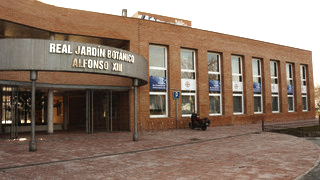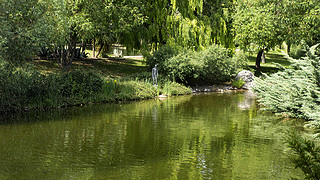
Campus Moncloa
Campus of International Excellence
Alfonso XIII Royal Botanical Garden

The Alfonso XIII Royal Botanical Garden is located in the heart of Madrid’s University Campus.
It was officially opened on 24th October, 2001 by the President of the Madrid Autonomous Community, Mr. Alberto Ruiz Gallardón and the University President, Mr. Rafael Puyol; it was opened to the public on 20th November of the same year.
The Park’s history, however, began almost a century before when the Board of the University Campus, which in 1927 was chaired by King Alfonso XIII, entrusted the arquitect Mr. Modesto López de Otero with the planning of a “university district”. It was at this time that a central area was earmarked for the building of a Botanical Garden.
After several attempts, it was not until 1997 with the support of University President Rafael Puyol that the definitive project was begun under the management of Mr. Fernando Gil Albert.
The Alfonso XIII Royal Botanical Garden belongs to the Complutense University of Madrid. The garden is home to more than eight hundred botanical species with the purpose of providing education, dissemination, conservation and research in botany and zoology.
A long avenue runs through the centre of the garden where large, white flower beds display typical species of the Mediterranean climate which is predominant in the Iberian Peninsula.
Two botanical paths lead off the avenue. These are lined with collections of shrubs arranged by botanical family. The garden’s collection of conifers and exotic trees is also visible from here.
The central plaza is enclosed by two semicircles. One of these is a “low maintenance area” where different species of the genus Quercus and accompanying shrubs have been planted. In this way a natural survival area has been created in order to improve results from the samples taken and experiments carried out by the different departments of the science faculty.
The Wangari Maathai Walk follows the other semicircle. This path is named for the first Kenyan woman to receive the Nobel Peace Prize for her contributions to the defence of the environment, democracy and peace. Renowned for her defence of sustainable development and human rights, the garden pays tribute to her in collaboration with the Women for Africa Association. This semicircle is home to a recently created rose garden with over one hundred different types of roses and a vegetable garden.
A stream runs through the western portion of the garden and flows into a pond which has a geyser or jet in the center. The banks of the stream offer a significant display of riverbank species.
The Alfonso XIII Royal Botanical Garden is a university garden and for this reason it mainly serves the academic community by providing an environment for various programmes.

The garden participates in the “CEI Campus Moncloa Fauna Monitoring Programme” which carries out fauna entomology censuses within an ongoing project for the inventory and monitoring of arthropod populations. The garden is also a permanent bird ringing station containing 20 nest boxes where the monitoring, study and census of birds is regularly carried out.
The garden has an educational department which provides guided tours. As well as walks through the garden there is a more extensive itinerary called the “Biodiversity Tour” that includes a visit to the Vertebrate Comparative Anatomy Museum and the Ethnobotanical Museum, both located in the Faculty of Biological Sciences.
The garden’s central plaza offers a self-guided tour and a typhlological museum on the geological history of the Earth, the “Biogeological Clock”. Here we can take a clockwise stroll around the plaza following the fifteen periods represented by the official colours and symbols. Information boards for each period explain the most important events that have shaped the Earth; we can listen to audio explanations, access further information via QR codes and touch sculptures of some of the organisms that appeared during the different periods.
As a means of furthering the garden’s educational and dissemination objectives the public can also visit the Biodiversity Interpretation Centre (CiBi). This space is divided into a botanical and general biodiversity exhibition area and a classroom workshop.
The privileged location of the Alfonso XIII Royal Botanical Garden in the centre of the Campus Moncloa makes it a place of relaxation and a meeting point for the entire university community.
Other services
- CIVA
- Accomodation
- Languages
- Culture
- Museums
- Sports
- Disability
- Alfonso XIII Botanical Garden
- Scientific Facilities
